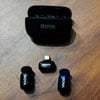Meta’s latest wave of smart glasses wasn’t just another flashy product reveal – it signaled that AI eyewear is finally edging into everyday life. At its Connect event last week, the company showed off three models that go well beyond novelty: the Ray-Ban Display with its discreet in-lens screen, the upgraded Ray-Ban Meta Gen 2, and the sport-ready Oakley Meta Vanguard.
Having used the original Ray-Ban Meta for the last year, I’m already sold on the benefits of smart glasses. Now, the lineup spans everything from everyday, hands-free info to sport-ready performance gear, and I’m looking forward to giving each a try. Here’s what to expect.

Meta Ray-Ban Display
The Ray-Ban Display is Meta’s first consumer glasses with a tiny screen built into the lens. A micro-LED display in the right lens can show directions, notifications, or text messages, all in your line of sight. It also has a 12-megapixel camera and audio built into the temples. The slim off-ear speakers sit just above your ears, so you can hear music, calls, or AI responses while staying aware of your surroundings. Five microphones handle voice pickup and video recording. Battery life is about six hours, with the charging case adding roughly 30 more.
Control is either by voice through Meta’s AI assistant or with the Neural Band wristband, which interprets tiny hand and finger movements. It looks simple in demos, just a subtle pinch or flick, but from testing plenty of gesture-based tech I expect it will take some practice before it feels natural. Once you get the hang of it, though, it’s far less clumsy than constantly reaching for your phone.
While I haven’t tried the Meta Display yet, I’ve used other smart glasses with embedded screens like Rokid Glasses ($499) and Halliday Glasses ($499), and I appreciate how handy a discreet, lens-mounted display can be. Meta’s slimmer, more attractive design should appeal to early adopters who see real value in having information pop up right in their line of sight.
Read more: Rokid’s New Smart Glasses Promise Accessibility Breakthroughs
The Meta Ray-Ban Display will be available September 30 for $799 on Meta.com.

Ray-Ban Meta Gen 2
The Gen 2 Ray-Ban Meta glasses aren’t as eye-catching as the Display, but they’re a meaningful upgrade for people who wear them daily as regular glasses or sunglasses. Battery life nearly doubles to about eight hours, and charging is faster, with half a charge in roughly 20 minutes. The 12-megapixel ultra-wide camera captures sharper photos and 3K video, making hands-free shots or quick clips easier than ever.
I’ve worn Ray-Ban Metas for over a year, adding prescription lenses to mine, and I use them for everything from snapping photos and videos to translating menus and signs while traveling. (I'm wearing them in the photo below) There’s no lens display, but the AI assistant and built-in speakers save me from reaching for my phone every time I have a question.

For example, while e-bike riding in France, I used my Ray-Bans to snap photos and videos without ever taking my hands off the handlebars. I leaned on Meta’s AI to ask about historic buildings or identify flowers I came across. Using AI did drain the battery faster, so the Gen 2’s longer battery life and sharper camera are welcome upgrades.
Read more: See the World Smarter: Ray-Ban Meta Glasses Get Multimodal AI
With classic styles like the Wayfarer and Skyler, plus options for polarized, transitions, and prescription lenses, these glasses blend in seamlessly and don’t make me feel like I’m wearing oversized AI chatbots on my face. Starting at $379 and available now on Amazon and Meta.com, they’re designed for individuals who want an AI assistant that still maintains a stylish appearance.

Oakley Meta Vanguard
The Oakley Meta Vanguard is built for athletes and outdoor enthusiasts. Its wraparound frame is water- and dust-resistant (IP67) and stays put with a secure three-point fit. A centered 12MP ultra-wide camera shoots stabilized 3K video with slow-motion and hyperlapse modes. Battery life is around nine hours, enough to last through long rides, runs, or outdoor adventures. These glasses are designed to work with your fitness ecosystem, syncing to apps like Garmin and Strava and automatically capturing milestones such as speed and elevation.
For me, the appeal of AI-powered glasses is having instant access to information without fumbling for a phone. With the Vanguard, that means hands-free recording, checking performance stats, or capturing a spontaneous moment while staying focused on the activity.
The Oakley Meta Vanguard cost $499 and are available for pre-order on Amazon and Meta.com with a ship date of October 21.
The bottom line
Overall, I find the Meta AI smart glasses comfortable, stylish, and genuinely useful, and I’m constantly amazed at how much they resemble regular glasses. They could be a little thinner and lighter, but I’ve been wearing Ray-Ban Metas as my everyday sunglasses for over a year and haven’t looked back. The new Display model is slightly thicker, but in demos, they look like regular glasses, and there’s no obvious sign that the user is looking at a screen.
In my experience, the AI provides instant answers without having to take a photo, like you would with Google Lens. I can get translations, directions, and follow-up answers completely hands-free. Privacy concerns are valid, given Meta’s data practices and the always-on microphones and cameras, but for me, the trade-off feels worth it. I already accept that companies like Google collect massive amounts of personal data, and the convenience of hands-free, context-aware information is invaluable. Others may feel differently, so anyone considering the glasses should weigh that convenience against their comfort with sharing information with Meta.
[Image credit: Meta, Andrea Smith/Techlicious]
















